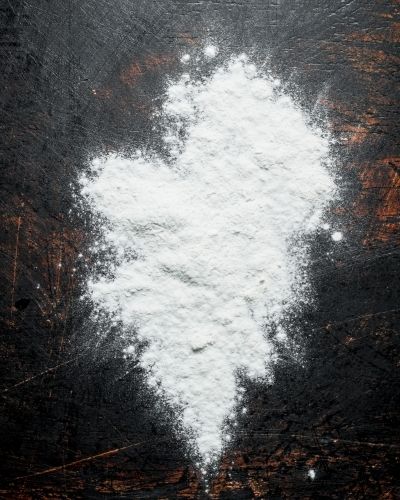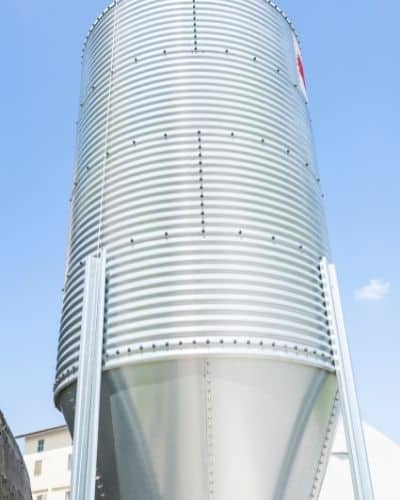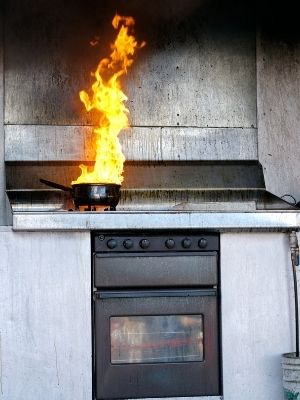If a fire breaks out in a kitchen, our instinct is to find a way to smother the flames and get it under control as soon as possible. Some people may reach for the nearest bag of flour, assuming that this fine powder will be a great way to cover the flames and starve them of oxygen. But, is this really a good idea or should you use something else?
Flour cannot put out a fire and you should not throw flour onto flames under any circumstances. There is too high a risk that the particles will ignite. Flour is a flammable substance that won’t smother flames and at its worst can cause dust explosions. Stick with baking soda or salt or simply get out and call the fire department.

The potential fire risks of flour aren’t well understood and homeowners must appreciate that not only should they never use it on a fire, but that high concentrations of flour particles can be dangerous. So, let’s look more at the dangers of flour and what you can use instead if you have a kitchen fire. We will consider the following.
- Why flour is so dangerous on a fire
- What makes flour flammable
- What dust explosions are and how they relate to flour
- Alternative kitchen ingredients that will work on a kitchen fire
- When to call for help
Table of Contents
Why should you never put flour on a fire?
The problem with flour is that it is a flammable material and will react to high heat. The heat from the flames can cause the flour particles to explode and a series of these small explosions can cause serious problems.
The remaining grease in the pan could spit, potentially landing on your skin and burning you, or landing on another flammable surface. The reaction could also cause the flames to get more erratic and harder to control.
There is nothing about flour that will smother the flames or create the same dispersal of carbon dioxide as some of the better kitchen ingredients mentioned below.
What makes flour flammable?
The flammable nature of flour comes down to its form as a fine dry powder. A bag of flour where the ingredients are densely packed together isn’t that dangerous compared to a cloud of loose powder. It may burn, but not that well.

However, the greater surface area of loose flour particles increases the likelihood of them burning in a fire.
The speed at which flour burns and becomes a fire risk comes down to its classification as a carbohydrate. Carbohydrates tend to burn faster and hotter than a lot of other compounds.
Flour dust explosions.
It sounds remarkable to say that flour dust can explode, especially when we use flour so much at home and when baking with our small children.
So, it is important to understand the difference between a pile of flour on a kitchen counter and a dust cloud. A mass of flour on a surface isn’t a fire risk unless it happens to ignite due to a pre-existing fire.
Dust explosions require a different combination of variables and physics to turn a dry cloud of dust into a volatile explosion.
To begin with, it is all about the ratio of particles and the high surface area created when they spread out in the air. You will see how easily flour can create a dust cloud if you clap your hands together with dry flour on them.
This sort of concentration in a kitchen isn’t a problem. The problem comes when you have masses of flour particles continually circulating to form a large cloud in a contained atmosphere. If the cloud becomes too dense and there is a spark in the building, you can get a reaction between the flour and the pure oxygen.
This is called a fuel-air explosion.
These fuel-air explosions aren’t limited to flour dust either. Lots of different food items create fine powders during processing, such as coffee and sugar. You can end up with similar clouds that respond the same way under the wrong conditions.
Flour mill explosions.
The risk of flour dust explosions is pretty low in a domestic setting because there aren’t enough flour particles floating around in the atmosphere to ignite.
However, there are high risks of flour dust explosions in places like factories, large-scale baking facilities, and flour mills. This means that flour dust is a significant occupational hazard for anyone working in these facilities.
There are already health risks of respiratory illnesses to contend with, but improper ventilation and exhaust systems can also increase the risk of fire.
Thankfully, flour mill explosions are very rare because mill owners have to create the safest possible conditions for their workers.
There aren’t the same ventilation issues and dangerous enclosed spaces as there once were. But, freak accidents do happen. One of the most significant tragedies from flour explosions was that of the Washburn Mill in 1878, where 18 people died.

But, there was a fatality at a grain mill explosion in Nebraska where grain dust ignited in an elevator. This is where those variables of the small enclosed space, high concentration of dust particles, and the spark for the fuel-air explosion all come together more easily.
What should you use to put out a kitchen fire?
Now that we know why flour is such a dangerous substance, we need to consider what we should use instead.
It is a good idea to turn to items on hand in your kitchen cupboard when dealing with something like a grease fire in a kitchen. The quicker you can put something on the flames to try and smother them, the better your chances of getting the fire under control.
The right ingredient can help to bring a blaze down to the point where you can put a lid on the pan and extinguish the fire completely. It is all about starving the fire of oxygen so that it burns itself out.
There are two ingredients that you can try instead. They are:
- Salt
- Baking soda
Don’t mistake baking soda for baking powder because while they have similar labels, they react very differently in a fire. The flammable nature of baking powder means it will react a lot like flour and make the situation worse.
Why should you use salt on a kitchen fire?
As long as the fire isn’t too out of control, you could find that salt is a great alternative ingredient as a fire extinguisher.
Salt has a high melting point so the heat from the flames isn’t going to make it melt away before it can do any good. With enough of these crystals over the fire, you could have a much better chance of putting out the fire.
The other great thing about salt is that is it usually readily available and cost-effective. You can just unscrew the lid on a bottle of table salt, dump the contents on the flames, and then cover the pan with a lid or baking sheet.
Why should you use baking soda on a kitchen fire?
Baking soda is a great alternative option because it works in a lot of the same ways. You can dump large quantities of this powder onto the flames as a way of extinguishing them and bringing the fire under better control.
The bonus of baking soda is that it is basically just sodium bicarbonate, which is a common ingredient in Class C Fire Extinguishers for electrical fires. This makes baking powder good for appliance fires as well as grease fires.
Again, there is a high melting point but you also get a pretty instant chemical reaction where it releases carbon dioxide. The more carbon dioxide on a flame, the better the chance of displacing the oxygen the fire needs to survive.

Calling the fire service for kitchen and electrical fires.
It is important to remember that while there are great household ingredients that are substitutes for flour, this is only going to work on small controllable fires.
If one small pan catches because of the hot oil, you should be able to douse it in baking soda or salt, cover it, and be fine. You may also be able to handle small appliance fires by unplugging the device and using baking soda.
In some situations, there may be an extinguisher or fire blanket on hand that you can use, but probably not in a domestic kitchen.
So, if the fire is too big or spreads, play it safe and get out. Contain the fire as best you can, evacuate the building, and call 911.
So, can flour put out a fire?
While it may be tempting to try and douse a fire in this accessible powder in an emergency, you could do more harm than good. Flour is flammable and highly dangerous when the fine particles create clouds. This could make the fire even more dangerous.